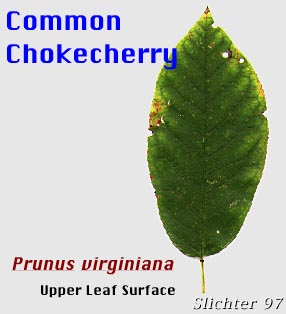 Characteristics:
Characteristics:
Chokecherry is an erect shrub or small tree from 1-4 meters high. The bark is purplish-gray and the younger twigs are reddish-brown. The bark lacks lenticels. The leaves are alternate on the stems with elliptic, oblong-ovate, or obovate blades from 4-10 cm long and petioles 5-15 mm long (with 2 glands below the leaf base). The tip of the blade is pointed while the base is rounded. The margins are finely toothed. The upper leaf surface is a shiny dark green while the lower surface is pale green.
The inflorescence is a terminal, elongated raceme of many flowers. The calyx of each flower is smooth surfaced with spreading or recurved lobes which are oval in shape and 1-1.5 mm long. Each of the 5 petals is suborbicular and 4-6 mm in length. There are approximately 25 stamens. The fruit is a red, purple, or black drupe which is ovoid in shape, 8-11 mm long, and sweet but astringent.
The fruits may be used for jellies, syrups, and wines. They were used fresh or dried and mixed in a pemmican for winter food by the Nez Perce. The bark was also used as a tea to relieve diarrhea and stomach ailments. The leaves, pits, and succulent shoots have high levels of cyanide while the pulp of the fruit is safe to eat. The cyanide levels can be lowered by drying and cooking. The leaves and twigs are a key mule deer browse, and the fruits are used by grouse, magpies, rabbits, and bears.
Chokecherry may be found from seacoast headlands to open forests to arid sagebrush-grasslands. Within those habitats, it likes some moisture, so is often found near seeps or springs, or along streams.
Chokecherry may be found from British Columbia south to California and east to Newfoundland, the Dakotas, Kansas, Missouri, Tennessee, and North Carolina.
